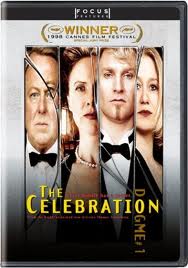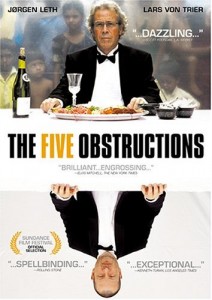It’s been awhile since the last installment, but the Queue is back with a vengeance this month, exploring genre-bending film techniques.
THE CELEBRATION (1998)
Director: Thomas Vinterberg
Trailer: http://www.youtube.com/watch?v=vKe_AxTFGXc
To the unfamiliar, “The Celebration” is arguably the pinnacle of the Dogme 95 film movement, begun in 1995 by director Vinterberg and colleague Lars Van Trier. In response to the growing use of special effects as opposed to story in film making, a group of directors (later to include Kristian Levring and Søren Kragh-Jacobsen) devised a series of rules imposed upon a film meant to return the focus to extreme story telling rather than extreme budgets. The rules are as follows:
1. Filming must be done on location with only props found at that location.
2. Sound cannot be produced separate from the images. Specifically music cannot be added unless it is within the scene being filmed.
3. The camera must be a hand-held. The film must not take place where the camera is filming, rather where the action takes place.
4. The film must be in color. Special lighting is not acceptable.
5. Optical work and filters cannot be used.
6. No superficial action is allowed (i.e. murders, weapons, etc.)
7. The film takes place in the present. No temporal or geographical alienation.
8. Genre movies are forbidden.
9. The final picture must be transferred on 35mm film, with an aspect ratio of 4:3.
10. The director must not be credited.
Imposition of the rules gives a certain flavor to the film, similar to a documentary, and puts the onus on the actors rather than the talents of the editing department. Obviously, this movement wasn’t for everyone (Michael Bay), but it certainly has a place in the annuals of film history. Most recently, Richard Dreyfus has expressed a similar sentiment when asked why he stopped acting. The films had simply become less about the actors’ craft, he said, and more about the skills of the production team.
“The Celebration” is the story of a family reunion centering on the 60th birthday of the patriarch, Helge. Various members of the family have traveled to the old man’s country estate. Introduced are his three children, Christian (Ulrich Thomsen), Michael (Thomas Bo Larsen) and Helene (Paprika Steen), as well as a reference to their fourth sibling Linda, Christian’s twin, who has committed suicide. At the celebration dinner, Christian is asked by his father to make a toast to the event and his sister. In response, he asks his father which of two toasts to make, one written on green paper and one on yellow. Helge chooses the green, the Speech of Truth. That truth reveals long-kept family secrets and the reason for Linda’s suicide.
To successfully pull off the 10 rules laid out above, the actors must be top-notch to carry the story. “The Celebration” pulls this off with superb performances from all members. While certainly not a dinner and date movie, this genre is worth exploring, even if only in this one film, to observe the difference between film making styles. In this particular case, the stylization of the Dogme movement pulls you into the action.
Acting 4.0
Character 3.5
Structure 4.0
Writing 3.75
OVERALL 3.75
THE FIVE OBSTRUCTIONS (2003)
Director: Jørgen Leth, Lars von Trier
Trailer: http://www.youtube.com/watch?v=IYrNwO7-AVI
To continue exploring pretentious Danish film making, “The Five Obstructions” is a documentary and investigative journey into one of director Jørgen Leth’s first films, “The Perfect Human.” The approach is unique, as protégé Lars von Triers lays out conditions for Leth to actually recreate his film. In all fairness, the film in question is Danish-famous; which is to say that even I hadn’t seen it before. This will not distract from the film, as adequate explanation of the scenes in question are provided during the discussion of how to fulfill the requirements laid out by von Trier. The obstructions presented are:
1. Remake the film in Cuba, with no set, and no shot longer than 12 frames. He must answer the questions posed in the original film.
2. Remake the film in the worst place in the world, but not show the place onscreen. Leth must play the role of “the man.” The meal is to be included, but the woman is not to be included.
3. Failure to complete number two prompts von Trier to punish Leth by choosing between remaking the film any way he chooses or redo number 2 again. Leth choose the first option using split screen effects.
4. Leth must remake the film as an animation.
5. von Trier has already made a fifth version, but must be credited as Leth’s and Leth must read a voice-over narration from his own perspective, but written by von Trier.
Von Trier is a co-founder of the Dogme 95 movement, so the application of filmmaking rules should not be a shock. What is exceptional in this case is the opportunity for the audience to take a ride with two directors as they dissect their art within defined limits.
The original film, “The Perfect Human,” is often criticized for being emotionally detached. The real goal of von Trier to is force Leth to make a bad film and in so doing, reveal emotions that were missing. Fortunately, he fails in this enterprise, as Leth finds ways to circumvent the obstructions and convey his message. The five remakes presented as vignettes are amazingly conceived even without a working knowledge of the original short film.
Acting 3.0
Character 3.0
Structure 4.0
Writing 3.0
OVERALL 3.25





Even in drama films special effects are usually very much needed.
I would agree. The Dogme movement certainly isn’t for everyone, but it does give a different perspective from the typical Michael Bay movie experience. My hope in this column is to give some exposure to more offbeat films and techniques.
These fall into that film for the sake of art category, which I enjoy to a degree. However, most nights everyone wants to be entertained more than enriched. Nothing wrong with that.
You could also say film for the sake of telling a great and meaningful story that could inspire/help/elevate people and their thinking.